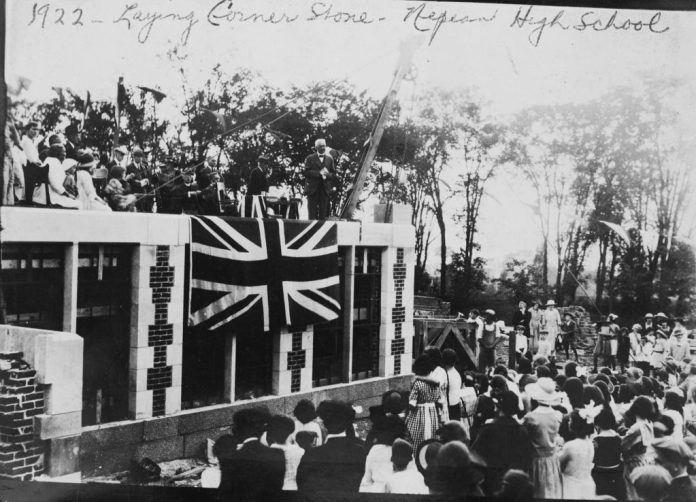By Dave Allston
A symbol of the emergence of Westboro into a popular, growing village in the 1920s, Nepean High School was built despite many years of politics and skepticism.
Now 100 years later, it is a west end institution that is recognized as one of the province’s top educational institutions. Over the past century, Nepean High has seen the world change around it. Once nestled between a golf course, a swamp and a rural housing development, the public high school is now the heart of one of Ottawa’s most popular, character-filled, and historic communities.
The story of Nepean High School, the institution, actually predates the building by about seven years. In September of 1916, the first “continuation class” for Nepean Township opened at old Churchill School (then known as Westboro Public School), after the Township had spent 20 years wavering on whether to establish a secondary school, what the focus of the school would be, and where it would be located.
The continuation class grew steadily in registrations, moving over to old Broadview School in 1917, and eventually taking over the whole upper floor there.
The biggest catalyst for the construction of a dedicated high school came in 1921 when the Adolescent School Attendance Act came into effect in Ontario, increasing the age of compulsory schooling from 14 to 16. This assured the need for a school in Nepean Township. The concept was not without its skeptics, however, many of whom argued that such a large school could never be filled in what was then still largely a farming community.
A High School District was created by Carleton County, which comprised about two-thirds of Nepean Township, and included the school sections of Woodroffe, Westboro, Britannia, Bells Corners, March Road, Eagleson’s Corners, Greenbank, City View, Merivale, River Road and Carlington.
In April 1922, the location for the school was chosen by the new Nepean High School Board, a five acre location on the former Highland Park dairy farm operated by the Cole family. John E. Cole sold the land to the Board for $13,000 (about $219,000 in present-day money).
The architectural firm of Richards and Abra was contracted to design the plans and specifications for the new school. Their initial plans called for a modest ten room school at a cost of $50,000, but the Board took an optimistic view that the surrounding neighbourhoods would continue to grow quickly, and expanded the plans to a 15 room building that cost $225,000.
Once the green light was given, construction happened quickly. Excavation work began in late May 1922 by Bate, McMahon & Co., and a month later tenders were accepted for the building work, which was won by the Ottawa firm of Taylor and Lackey.
The cornerstone was laid by the Minister of Education, Hon. R. H. Grant, in a grand ceremony on Sept. 11. As late as that fall, it was hoped that the school would be ready for Jan. 1, 1923, but the opening was eventually pushed to the fall of 1923.
The 1923-1924 school year saw a total of 195 students registered.
Nepean at its opening featured a chemistry room, physics room and a typewriting room. The physics room had no running water, but did have a row of electrical outlets. The chemistry room had running water, but no electrical outlets. There were a total of just six classes. The original auditorium, with non-installed seating and built to hold 400 students, opened later that year in December.
Nepean took in students from a wide area of the west end, stretching as far as Piccadilly Avenue and Western Avenue on the east, as far south as Colonnade Road, and Bells Corners, South March and Dunrobin to the west. Some students even travelled in from Vanier to take a commercial course only offered at Nepean. Many students came by streetcar down Byron Avenue, or those coming from the south or further west came via bicycles or skis, or on sleighs driven by their father or brother working in Ottawa. Students coming from further destinations often rented a room in Westboro, and would return home only on weekends.
A married couple, Alphonso “Pop” Kent and his wife Lilian, oversaw the school as the caretakers for the building and students. They actually resided in the basement year round, and did everything around the school, from its opening in 1923 until they retired in 1956. “Pop” Kent did all the maintenance and gardening around the school, ran the hand-fired furnaces, and kept the school clean. Mrs. Kent was the school “mom” who helped nurse illnesses and injuries, mended clothing rips, or provided a comforting shoulder to those who struggled. The couple also served hot chocolate on cold mornings, and provided lunches to those who had forgotten theirs, while also making refreshments for all school activities.
There were no water and sewers in Westboro in those early days, so the school obtained water through a well on the property and a cistern that collected rain water off the roof. Two large septic tanks at the rear of the school held the waste. Some gym classes during the winter months of that era consisted of snow shoveling.
Nepean’s first athletic success came in 1925, and one hundred years later it may still stand as its most significant, when the school’s rugby team unexpectedly won the city, regional, eastern Ontario, and finally the Dominion Inter-Scholastic Championship.
The first Broadview School next door burned in 1926 and so in a switch of roles from a few years prior, it was Nepean hosting Broadview’s students while their school was rebuilt.
In April 1947, Nepean held a ceremony at the school to honor the 46 former students who lost their lives in WWII. An illuminated honor roll was unveiled in the auditorium containing the names of the 642 former students who enlisted, and the 46 who had made the ultimate sacrifice. This honor roll continues to be displayed in the hall at Nepean.
Twenty five years after its opening, the school was bursting at the seams. It became clear that a major addition was required. So in Aug. 1947, a call for tenders was put out for the construction of a new wing on either side of the school (creating an H-shape). Once again, Abra was the primary architect involved (with his new firm Abra, Balharrie and Shore), designing a new 802-seat auditorium, gymnasium, cafeteria and additional classrooms. The construction contract was awarded to the Alex I. Garvock Ltd. and cost $442,973. As there was a major post-WWII building boom occurring at the time, materials were scarce and skilled labour was also challenging to find, so construction was slow.
Construction began in the summer of 1948. The new south wing opened on time for the first day of classes in Sept. 1949, but the north wing was delayed until its official opening on Dec. 15. The annexation of a large part of Nepean to Ottawa on Jan.1, 1950 meant that the Nepean board would be handing over to the Ottawa Collegiate Board a newly updated, modern school. With annexation, it was rumored that Nepean High School’s name would also change to Broadview Avenue High School, but of course that never occurred. The fact, though, that Nepean High School was no longer located within Nepean boundaries would lead to some confusion over the years.
This would not be the last of the additions to occur to Nepean High, as the school just kept on growing. In 1958, another major addition occurred when two labs, 10 classrooms, metal workshop, guidance room and a health centre were added, bringing the institution to 42 classrooms and 55 teachers. A new gymnasium was added in a separate project in 1966.
Meanwhile, in the late 1970s, portions of the school became tired and did not meet code. A four-phase renovation was implemented between 1978 and 1986, which included improvements to meet fire regulations and upgrading the library, guidance office and main office. The final phase in 1986 was a $3.2M renovation upgrading the science rooms, building a greenhouse, renovating the northwest wing, and a major upgrade of heating, electrical and mechanical equipment.
Though no new additions have been added since, the first portable classrooms arrived around 2000. Though there were just two at first, there are now six that sit on the former back tennis courts.
Nepean boasts many accomplished alumni in its ranks, too numerous to list here, but it is not hard to stumble across people in all areas of life – medicine, law, business, sports, music, etc. – who are former Nepeanites, who would doubtlessly attribute the impact Nepean High had on their early years as a big part of their success. The 75th anniversary gathering in 1998 brought thousands of former students to the school for an exceptional party, and it’s unfortunate a similar event was unable to be planned for the important 100th anniversary this past year.
However, we are still lucky to have such an important and historic institution in our community, one which it is hard to believe originated with a nine-student class in 1916 and a relatively small 15-room building in 1922. May it continue to thrive for another 100 great years and more in Westboro.
Editor’s note: Dave Allston is a graduate of Nepean High School.

